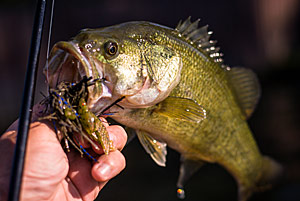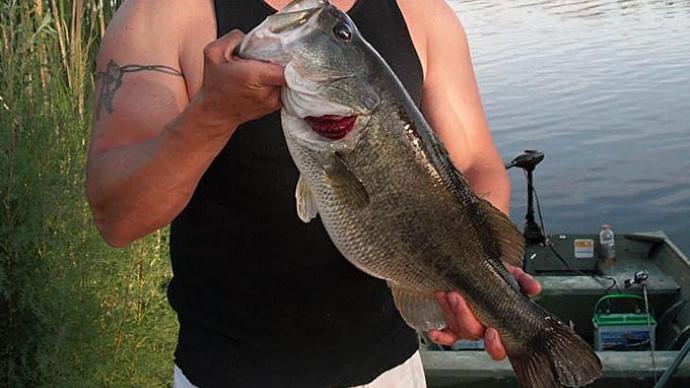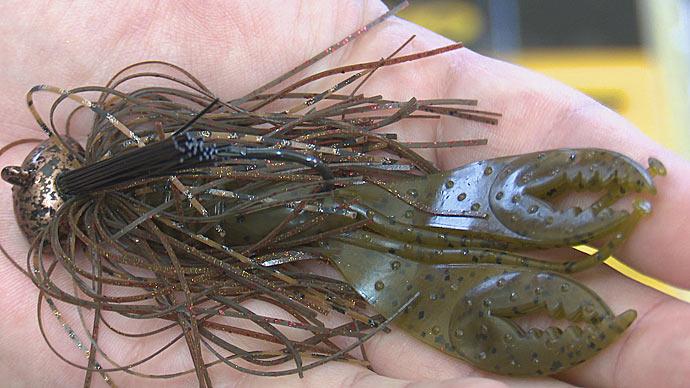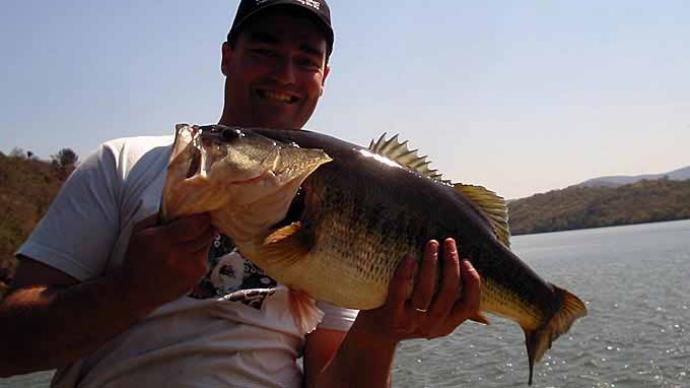
Last month I wrote about getting your gear set up for jig fishing in the spring. Now that you're all rigged up, here's how you use it to catch some of the biggest bass that swim in your lake.
Start your jig fishing by choosing a likely location. Remember that big female bass are working their way to shallow spawning flats early in the spring and then back to deep water after they finish. Intercept the bass as they travel along these routes by concentrating on areas with thick cover or quick drops to deeper water, preferably both. Especially after cold fronts, bass hunker down by the thickest available cover or fall back to the first deeper water.
While they won't be as active, the bass often group up in small areas, and the fishing can be fantastic once the honey holes are located. Therefore, key on grass, rock, wood, docks, or other cover along creek channels and points adjacent to spawning areas. In addition, I catch a lot of bass on Lake Fork Trophy Lures' Mega Weight jigs on banks where bass are actively chasing spinnerbaits and lipless crankbaits. Fish your jig on the edge of the grass or near stumps in these areas, and you'll likely catch lunker bass that are reluctant to run down faster baits.
Once you're in a good jig area, boat position and casting accuracy play a big part in your success. Facing the wind will allow you to control your boat better and keep you from drifting up onto critical targets. As a general rule, the clearer the water and the thinner the cover, the greater the distance you need to keep between the target and your boat. If I'm fishing heavy wood or grass cover in muddy water, I'll get close and flip or make short pitches with my jig. Conversely, long pitches or roll casts are required in thin cover in clear water.
Learning to roll or loop cast your jig allows pinpoint accuracy and a quiet entry into the water from great distances, and this method also allows for rapid-fire casts. Kevin VanDam and Jimmy Houston are two masters of this technique, so if you're not familiar with the roll cast, pay close attention the next time you see them on TV. Ultra-stiff rods are tougher to make roll casts with, so go for a strong rod with a bit of tip, like the Dobyns Rods 736C model I wrote about in part one. Learning to place your lure close to the target and quietly is the key to success; as a result, improving your casting accuracy is an easy way to become a better jig angler.
Finally, make repeated casts to likely targets. Remember that you're often fishing for wary lunkers that are inactive after a front. Place an easy meal right in front of their face by pitching every nook and cranny of their lair, and you can often trigger a bite.
Speaking of triggering a bass to bite, it is often a function of working your jig with the correct action and rate of fall. Since the preferred action changes daily, you'll need to experiment with your presentation and jig set up until you find what works best. Usually, most of your bites will come on the initial fall of your jig as it drops to the bottom for the first time. Some days a rapid fall triggers a reaction bite, while other days, you'll need a prolonged fall to keep the jig in the strike zone for as long as possible. Use heavy jigs, light lines, thin skirts, and small streamlined trailers like Fork Craws for a faster fall. Go with lighter jigs, heavy lines, and large bulky skirts and trailers like Hyper Freaks and Fork Creatures for a slower drop.
When bass aren't hitting the bait on the drop, frequently the case in early spring, you'll need to figure out how to work it back to the boat. You can drag it, give it small or large hops, shake it in place, or just let it sit. These work at different times, and determining how much or how long to let hop or rest a jig is a piece of the puzzle you need to decipher each trip.
Assuming that you've done everything correctly so far, sooner or later, a fish will bite. Unlike a plastic worm that bass will usually swallow before letting go, it'll spit out a jig with too much pressure on the line as the bristly weed guard or sharp hook starts to press against the fish's mouth. Therefore, take up your slack and lift it gently each time before moving your jig forward. Over time, you'll develop a feel for the resistance of your jig and trailer coming through open water, weeds, or wood.
Anytime the resistance on your jigs feels a bit heavier or lighter than usual, it is time to set the hook. Every good jig fisherman I've fished with has set the hook several times on weeds, limbs, or just a hunch. If you're not setting the hook and coming up empty on occasion, you're probably missing some fish that are gently picking up and dropping your bait. Of course, sometimes you'll feel a large thump, or you'll have the rod jerked out of your hands, but it usually is a much subtler clue, especially for the big fish. In addition, please pay close attention to your line and watch it where it enters the water. Any time your line jumps starts moving to the side, or stops falling in less time than is required to reach the bottom, set the hook without delay.
So there you have it, my theories on jig fishing. Lots of variables to consider, but control the ones you can by using quality gear, like Dobyns Rods and Lake Fork Trophy Lures' baits; and by improving your casting accuracy and boat positioning. You will have a good head start on catching a lunker by doing so.




